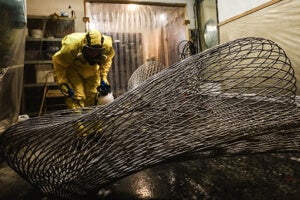3D printing is stuck in a box.
Most of the printers on the market are relatively small, and the scale of objects is limited by the print area. This is acceptable for parts, tools, or toys. But let’s say you want to print something bigger—like a building. You could scale the box up and print it piece by piece, assembling the pieces on site. Or you could get rid of the box entirely.
The Dutch design company, MX3D, is opting for the latter approach. They’ve developed computer-guided robotic arms tipped with welders to 3D print a steel bridge in midair over a canal in Amsterdam.
The bridge project, in partnership with Autodesk and a number of other supporters, is possible thanks to MX3D’s earlier efforts to 3D print using six-axis robotic arms. MX3D’s robotic arms are computer-guided, driven by digital designs as complex and ornate as you like, and can draw metal in midair like mutant spiders.
The robots print using steel, stainless steel, aluminum, bronze, or copper. They make lines in the air, without the need for support structures, by sequentially building welds in any direction in space.
And eventually they’ll even print tracks to move along as their creation materializes below.
Autodesk is supplying the smarts, working with MX3D to make the specialized software driving their robots. They first began printing resin before graduating to metal. Then early last year, the team demonstrated how the technology could print supportless metal structures in the air.

The ultimate goal? In fall of 2017, they’ll set up robots on opposite banks of a canal in Amsterdam (final design and location TBD) and hit the print button. Over the course of two months, the robots will simultaneously print the bridge from each bank, eventually meeting in the middle to join the halves.
“This being the Netherlands, we decided a bridge over an old city canal was a pretty good choice,” MX3D’s Joris Laarman told Fast Company. “Not only is it good for publicity, but if MX3D can construct a bridge out of thin air, it can construct anything.”
The finished bridge will measure 24 feet long. Constructed using a steel composite specially developed at the University of Delft, it will be as strong as any other bridge and able to handle regular foot traffic for years to come. That is, it isn’t just experimental, they hope it’ll practical too.
The merger of 3D printing and building isn’t a new idea. Inventors have long dreamed of 3D printing houses.
USC’s Behrokh Khoshnevis, for example, first started work on his “contour crafting” technique over a decade ago. Chinese company, WinSun, showed off 10 3D-printed houses to much fanfare (and some controversy) last year. WinSun prints the houses in pieces in a factory and assembles them on site. Meanwhile, another modular 3D-printed house is taking shape in Amsterdam—although the team’s Kamermaker 3D printer resides in an giant box.

Concrete and steel being primary ingredients in modern architecture, we imagine MX3D’s technology (or something like it) could one day work in tandem with a concrete 3D printer. But using the story of 3D-printed houses as a cautionary tale—challenges remain, and it may not happen right away.
Whenever the technology does come of age, however, the dream of automated machines spinning complicated digital designs into infrastructure on a grand scale is without question alluring.
Maurice Conti, head of Autodesk’s Applied Research Lab, sums it up like this, “Imagine some day in the future, just going somewhere, dropping off a robot, and coming back two months later to have this huge piece of infrastructure there, without any human intervention at all!”
Image Credit: MX3D



